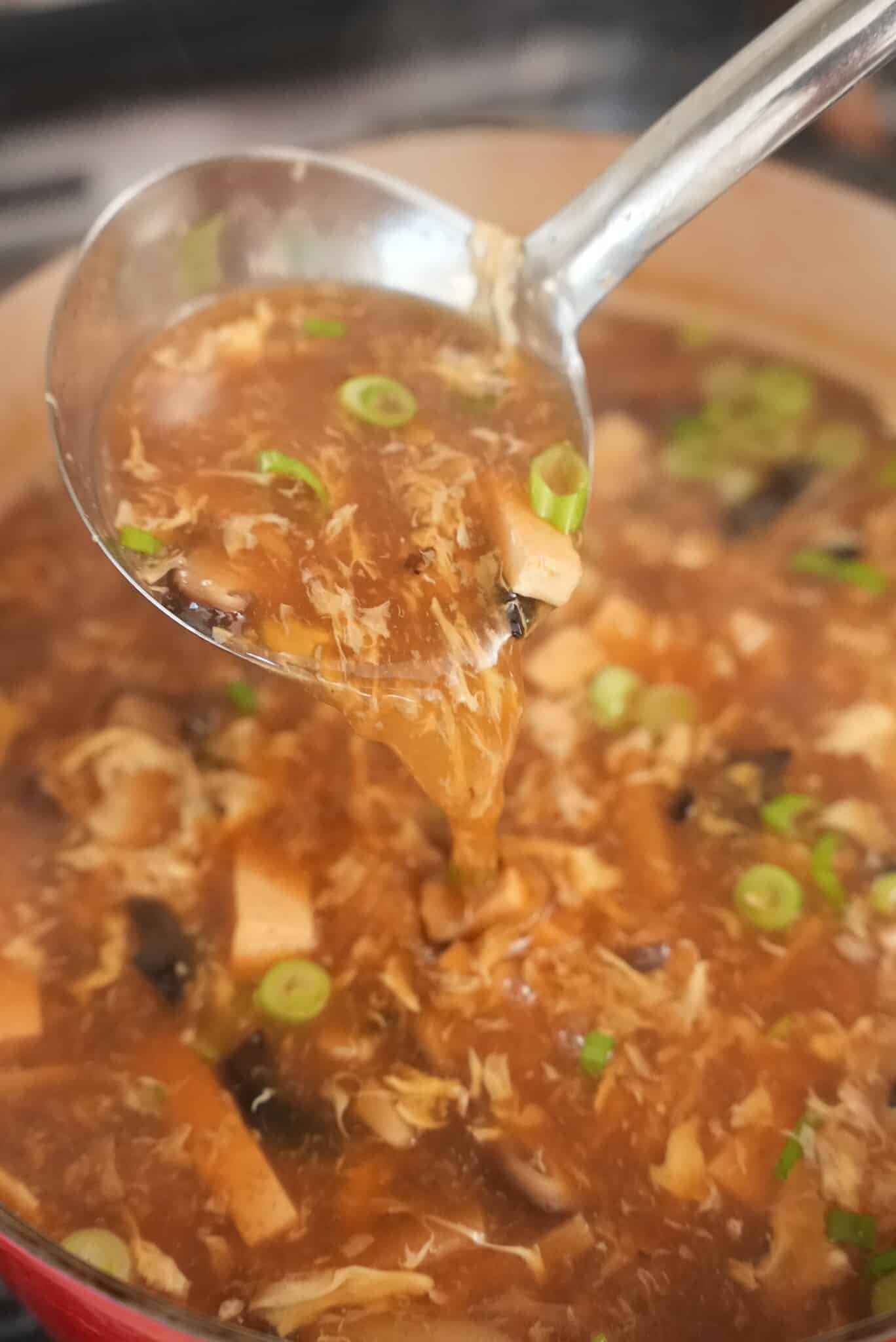Chinese Spicy Hot and Sour Soup: Origins, Ingredients, and Health Benefits
Chinese Spicy Hot and Sour Soup dates back to the Warring States period (475-221 BCE). Traditional medicinal practices prioritized balancing flavors to promote health. Tangy vinegar, fiery chili, and umami-rich proteins exemplified this philosophy. Over the centuries, regional influences shaped the recipe, incorporating local ingredients to enhance its distinct taste. Ancient texts, like the Compendium of Materia Medica (1590s), also documented the soup’s health benefits, solidifying its culinary importance.
Regional Variations
Various regions in China offer unique takes on Spicy Hot and Sour Soup.
- Sichuan: Renowned for its bold flavors, Sichuan versions use vinegar and chili oil extensively, often featuring bamboo shoots and tofu.
- Hunan: This variation emphasizes a smokier heat. Incorporating pickled vegetables adds depth.
- Northern China: Northeastern recipes often incorporate pork or lamb, delivering a heartier version that aligns with the region’s climate.
Each regional adaptation reflects local tastes and available ingredients, providing a diverse landscape of flavors united by the soup’s foundational spicy and sour profile.
Key Ingredients in Chinese Spicy Hot and Sour Soup
Choosing the Right Spices
Spices define the complexity and depth of Chinese Spicy Hot and Sour Soup. A balance of these spices gives the soup its characteristic flavor. Sichuan peppercorns provide the numbing sensation, while dried red chili adds heat. Ground white peppercorns contribute to the underlying spiciness. Black vinegar offers a tangy undertone, enhancing the overall taste. These spices not only add flavor but also align with traditional Chinese culinary practices.
Essential Vegetables and Proteins
Vegetables and proteins make the soup hearty and nutritious. Black fungus, bamboo shoots, and shiitake mushrooms are common examples providing texture and umami. Tofu adds protein and absorbs the soup’s flavors well. Sliced pork or chicken provides additional protein options. These ingredients ensure the dish is well-rounded, complementing the spicy and sour profile.
With these essential spices and ingredients, the soup achieves its distinct, balanced taste, catering to those seeking authentic Chinese flavors.
Cooking Techniques for the Perfect Texture
The Importance of Timing
In creating Chinese Spicy Hot and Sour Soup, timing plays a critical role in achieving the perfect texture. Begin by preparing your stock, allowing it to simmer gently for a minimum of 30 minutes. This step ensures the base flavors meld together seamlessly. Next, add your vegetables (mushrooms, bamboo shoots) and proteins (tofu, pork) in a staggered sequence. Start with ingredients that require a longer cook time, like pork and mushrooms, then introduce quicker-cooking elements such as tofu and bamboo shoots. Incorporate the cornstarch slurry slowly while stirring constantly. This avoids clumping and thickens the soup uniformly. Finally, pour in beaten eggs in a thin stream, swirling gently to create delicate egg ribbons.
Tips for Balancing Flavors
Balancing flavors is essential in Chinese Spicy Hot and Sour Soup. Combining spicy, sour, salty, and umami elements achieves a harmonious taste profile. Begin with high-quality Sichuan peppercorns and dried red chili for spice; toast both briefly to release their full aroma before adding them to the soup. Employ Chinkiang vinegar for an authentic sour component; add gradually, tasting as you go to reach the desired sharpness. Soy sauce contributes saltiness and a deep, savory note. Additionally, fresh ginger and garlic provide a pungent base, while a dash of sesame oil at the end adds a rich, nutty flavor. Adjust the seasoning continually to maintain balance, ensuring each spoonful offers a complex yet cohesive experience.
Serving and Pairing Suggestions
Ideal Side Dishes
Complement your Chinese Spicy Hot And Sour Soup with a variety of side dishes to create a balanced meal. Steamed dumplings (like pork or vegetable) offer a savory counterpoint. Chewy, fresh spring rolls filled with shrimp or vegetables provide a refreshing contrast to the soup’s robust flavors. Steamed bok choy or Chinese broccoli adds a nutritious, crunchy element. Offering jasmine rice or fried rice incorporates a comforting and filling staple. These side dishes enhance the overall dining experience with their textures and flavors.
Beverage Pairings
Select beverages that balance and elevate the complex taste of Chinese Spicy Hot And Sour Soup. Green tea, particularly jasmine or oolong, cleanses the palate and highlights the soup’s spices. Plum wine introduces a fruity sweetness that complements sour notes. For a non-alcoholic option, try chilled chrysanthemum tea, known for its floral fragrance and lightness. Light lagers or wheat beers match well, adding a refreshing finish without overpowering the soup’s tastes. These drinks harmonize with the soup, enhancing your culinary experience.
Health Benefits of Chinese Spicy Hot and Sour Soup
Nutritional Breakdown
Understanding the nutritional components of Chinese Spicy Hot and Sour Soup provides insights into its health benefits. The soup often includes ingredients like tofu, mushrooms, bamboo shoots, and various spices. These components add a variety of essential nutrients:
- Tofu: Rich in protein, calcium, and iron, tofu supports muscle function and bone health.
- Mushrooms: Provide selenium, antioxidants, and B vitamins, which boost immune function and cellular health.
- Bamboo Shoots: Low in calories and high in fiber, bamboo shoots aid digestion and support weight management.
- Spices (e.g., chili peppers, white pepper): Contain capsaicin, which has anti-inflammatory properties and can enhance metabolism.
Potential Health Enhancements
Chinese Spicy Hot and Sour Soup contributes to health improvements due to its varied ingredients. Benefits include:
- Boosts Immune System: Ingredients like mushrooms and white pepper enhance immune response.
- Aids Digestion: Bamboo shoots and the soup’s broth base promote smoother digestion.
- Supports Weight Management: Low-calorie, high-fiber components help you feel full longer.
- Anti-Inflammatory Properties: Chili peppers and other spices reduce inflammation and improve metabolic health.
- Balancing Electrolytes: Sodium and potassium content helps maintain fluid balance, which is crucial for overall health.
Understanding these nutritional and health benefits, you can incorporate Chinese Spicy Hot and Sour Soup into your diet for a flavorful and beneficial meal.
Conclusion
Chinese Spicy Hot and Sour Soup isn’t just a flavorful dish; it’s a powerhouse of nutrition and health benefits. Whether you’re looking to boost your immune system, improve digestion, or enjoy a delicious meal, this soup has got you covered. Pair it with dumplings or your favorite beverage to elevate your dining experience. By incorporating this soup into your diet, you’re not only savoring a rich culinary tradition but also investing in your well-being. So, next time you’re in the mood for something spicy and sour, remember that this soup offers much more than just great taste.





